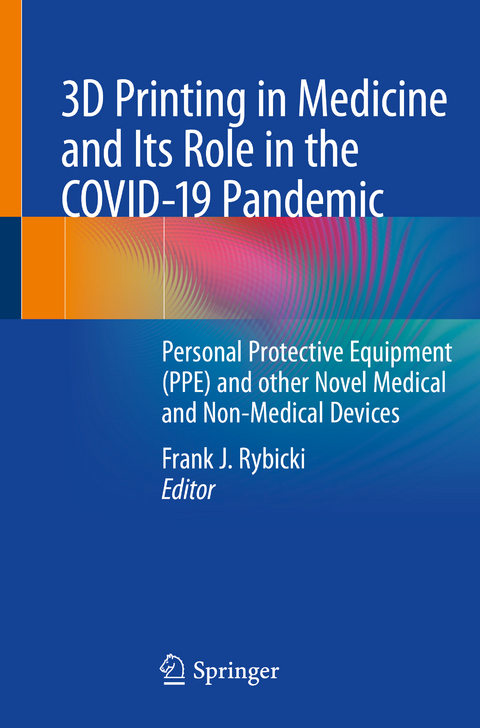
3D Printing in Medicine and Its Role in the COVID-19 Pandemic
Springer International Publishing (Verlag)
978-3-030-61992-3 (ISBN)
Subsequent chapters highlight some of the "maker" communities' efforts that made a difference in their part of North America. Each contribution describes the unique experiences, challenges, and successes.
While this book is written and edited mostly from a medical perspective, additional input from medical engineers, administrators, attorneys, and public safety officials enables a broad perspective to highlight some of the ingenuity from the North American 3D printing community who responded to the initial case volumes of COVID-19.
Dr. Rybicki pioneered medical 3D printing, beginning with his global introduction of full-face transplantation surgical planning; his discoveries and opinions have been published in New England Journal of Medicine, Lancet, and other multidisciplinary journals. At RSNA 2013, his laboratory's presentation (as published in American Journal of Transplantation) included a Press Conference demonstrating the impact of clinical 3D printing; it was covered by all major television networks. Via the Associated Press the release had over 150 major US and international media feeds; the RSNA has officially reported an audience of 783 million individuals.
Dr. Rybicki developed and moderated the world's first radiology-based society-CME educational program in medical 3D printing. This and related programs managed by Dr. Rybicki have provided the opportunity for the first 1,200 radiologists and imaging scientists to obtain radiology-based CME for live software training in the field of 3D printing. He is Editor-in-Chief of the BMC peer-review journal 3D Printing in Medicine that launched in the fourth quarter of 2015. He co-edited with Dr. Gerald T. Grant a book 3D Printing in Medicine: A Practical Guide for Medical Professionals, published in October 2017.
In the Fall of 2016, after founding the organization one year earlier, Dr. Rybicki was named the first Chairperson of the RSNA Special Interest Group (SIG) on 3D Printing, initiating a new chapter for the field of medical modeling. The 400 members have supported Dr. Rybicki when, in September 2018, as part of an ACR team he co-led the successful AMA/ CPT application for category III billing codes for anatomic modeling (active July 1, 2019). He has also mentored the current SIG leadership team in the development of society guidelines and position statements that will steward 3D printing into the healthcare sector.
Chapter 1Introduction.- Chapter 2 Literature and Media Based Review of Personal Protective Equipment 3D Printing Efforts during COVID-19.- Chapter 3 3D Printing and other Manufacturing during COVID-19: Success Stories and Lessons Learned by Makers at the University of Cincinnati.- Chapter 4 The role of National Institutes of Health (NIH) 3D Print Exchange in supporting leadership and collaboration for frontline 3D printed personal protective equipment (PPE) efforts.- Chapter 5 Crisis Response 3D Printing: Developing and Producing a 3D-Printed Nasopharyngeal Swab for COVID-19 Diagnostic Testing.- Chapter 6 Rapid 3D Printing Response for Respiratory Support Apparatus Needs: Ventilators, Connectors, and Other Respiratory Support Devices.- Chapter 7 Practical Frontline 3D Printing in COVID Response at the Intensive Care Unit: Laryngoscopes and Beyond.- Chapter 8 Production of Protective Face Shields in Cincinnati, Ohio USA from the 1819 Innovation Hub at the Universityof Cincinnati.- Chapter 9 3D printing of Face Shields and Ear Tension relief devices during COVID-19 at the Touro College of Osteopathic Medicine.- Chapter 10 3D Printing in New York City during the Height of COVID-19: Realities and Success Stories from the Front Line.- Chapter 11 3D Printing of Open Source N95, Surgical and Community Mask Designs to Address COVID-19 Shortages.- Chapter 12 Sterilization 3D Printed Parts used as Medical Devices and in the COVID-19 Pandemic.- Chapter 13 3D Printing of Non-medical Devices during the COVID-19 pandemic.- Chapter 14 The Next Pandemic and Resilience through Strategic Manufacturing Reserves: Applying the Lessons of COVID-19 and Medical 3D Printing and other Manufacturing.
| Erscheinungsdatum | 13.01.2021 |
|---|---|
| Zusatzinfo | X, 127 p. 61 illus., 52 illus. in color. |
| Verlagsort | Cham |
| Sprache | englisch |
| Maße | 155 x 235 mm |
| Gewicht | 274 g |
| Themenwelt | Medizin / Pharmazie ► Medizinische Fachgebiete ► Notfallmedizin |
| Medizin / Pharmazie ► Medizinische Fachgebiete ► Radiologie / Bildgebende Verfahren | |
| Studium ► Querschnittsbereiche ► Prävention / Gesundheitsförderung | |
| Sozialwissenschaften | |
| Schlagworte | 3D Printing • Additive Manufacturing • Coronavirus • COVID19 • face masks • Face Shields • Medical Devices • N95 Respirators • Pandemic • Personal protective equipment • PPE • Rapid Prototyping • Rapid Response • SARS-CoV-2 |
| ISBN-10 | 3-030-61992-3 / 3030619923 |
| ISBN-13 | 978-3-030-61992-3 / 9783030619923 |
| Zustand | Neuware |
| Haben Sie eine Frage zum Produkt? |
aus dem Bereich


